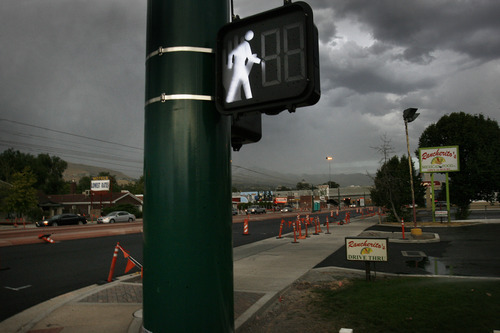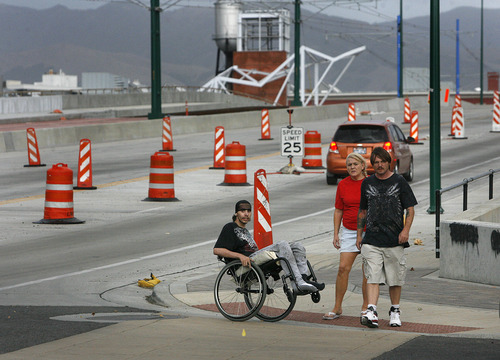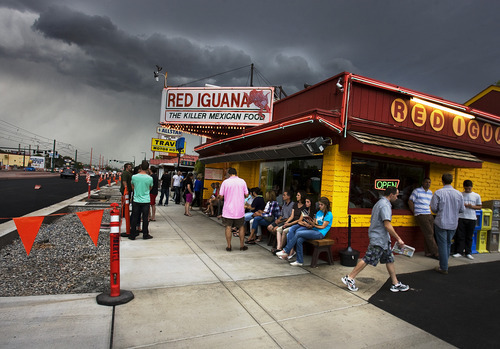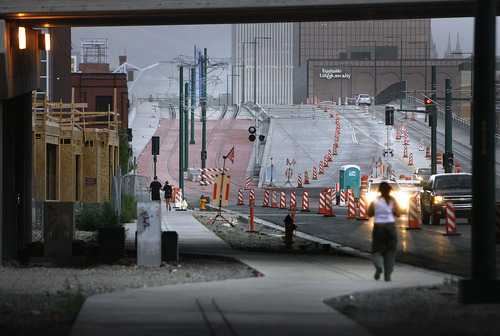This is an archived article that was published on sltrib.com in 2012, and information in the article may be outdated. It is provided only for personal research purposes and may not be reprinted.
University of Utah researchers are taking advantage of a major Salt Lake City corridor's overhaul to document whether a pedestrian-friendly environment actually gets people out of their cars and exercising more.
As the $290 million renovation of North Temple and installation of the airport TRAX line near completion later this year, principal investigator Barbara Brown needs a few hundred more residents to agree to occasional interviews — and to wear electronic monitoring devices that track movement.
The data will help determine how residents' activities and their intensity level change after North Temple is equipped with wide multi-use sidewalks, bike lanes, a multi-use path, fewer traffic lanes, trees and a light-rail line, according to Brown, a professor of family and consumer studies and principal investigator on the study.
Funded with a $3 million grant from the National Cancer Institute, Brown and U. colleagues are conducting the multi-year Moving Across Places Study, exploring North Temple residents' attitudes about their neighborhood before and after the project.
What's the cancer connection behind the federal funding? There is a strong association between lack of activity and two of the most common malignancies, cancers of the colon and breast, said study collaborator Ken Smith of the U.'s Huntsman Cancer Institute. People who don't exercise also demonstrate increased risk for cancers of the prostate and lungs.
Many common cancers are difficult and expensive to successfully treat, so simple steps, like engineering streets that invite walking, could have broad benefits when spread across entire populations, said Smith, also a professor in the department of family and consumer studies. And lowered cancer risk is just one of many potential benefits of walkable neighborhoods, which include improved health, enhanced quality of life, and reduced fuel consumption and air pollution.
The Utah Transit Authority is building a six-mile TRAX extension from downtown to the Salt Lake City International Airport. The city is leveraging that project to turn North Temple into a "complete street," with $22.6 million in features to make it safer and more pleasant for those on foot, riding bicycles or using transit.
The changes include buried utility lines, railings, new lighting, colored pavers and irrigated landscaping, according to city engineer John Naser.
Before the city began demolition three years ago, North Temple exemplified post-World War II suburban development — when residential corridors were re-engineered to move cars through as efficiently as possible. Brown believes these changes in the American urban landscape contributed to the alarming epidemic of obesity.
"People blame obesity and inactivity on personal character, but really you need environmental supports to have a healthy lifestyle," Brown said. "For obesity rates to change so fast it can't be personal traits or genes. It has to be something in the environment."
North Temple has also suffered from under-investment that rendered it a place for pedestrians to avoid, severing Salt Lake City's west side.
"A lot of people have written off the west side when there are a lot of great neighborhoods here," said nine-year North Temple resident Mike Christensen, a study participant who happens to be a U. graduate student of urban planning.
He owns a townhouse near 500 North and Redwood Road and usually commutes to campus by bus and TRAX.
For one week last month, Christensen wore a GPS unit and an accelerometer on his waist. The devices recorded a great deal of data, which a research assistant uploaded to a website for analysis. The information was plotted on a map that showed where he walked, ran, cycled, drove and rode transit.
The research assistant asked Christensen to describe his experiences during those activities.
"We're not looking at clinical outcomes but things that matter to people on a day-to-day basis, like how much they like their neighborhood," Brown said. "It's not just about cancer. It's about a more livable community."
Brown's study will initially track 800 participants who live within 1.2 miles by foot of North Temple. Her team has recruited and interviewed more than 400 and has set a deadline of late October to complete the first round of interviews. They are looking for a diverse cross-section by block of residence, age, race, gender and socioeconomic groups; Spanish speakers are welcome. Children, pregnant women and those who can't walk far won't be included in the study.
Moving Across Places Study
University of Utah researchers are recruiting Salt Lake City residents who live within 1.2 miles of North Temple between 200 West and 2200 West for a study of how the street's renovation will affect their interactions with the neighborhood. Interested residents can call 801-585-3754 or e-mail mapstudy@fcs.utah.edu.
Those who complete all parts of the study will earn $50.









